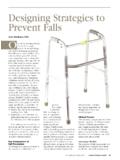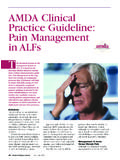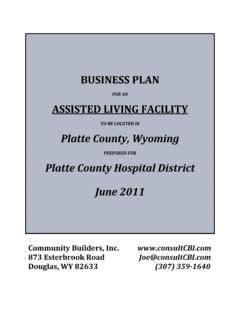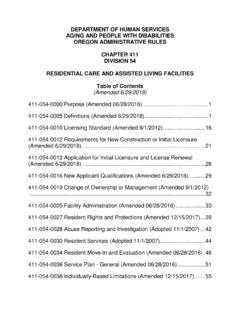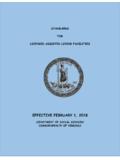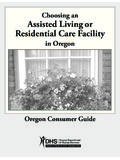Transcription of Assessment and Management of Behavioral Symptoms in ...
1 November/December 2005 assisted living Consult7 Mrs. Jones screams ob-scenities at her Robinson slapped aserver in the dining room last Taylor sometimes spits at med-ication aids. These kinds of situa-tions are not uncommon in assistedliving facilities. In fact, approximate-ly one-third (34%) of residentialcare/ assisted living facility residents(RC/ALF) exhibits one or more be-havioral Symptoms at least once aweek. Thirteen percent exhibit ag-gressive Behavioral Symptoms , 20%physically nonaggressive behavioralsymptoms, 22% verbal behavioralsymptoms, and 13% resist takingmedications or performing activitiesof daily living situations can be stressfuland upsetting for residents, staff,and visitors alike. They even canput individuals at risk of physicalinjury. So, clearly, it is in the facili-ty s best interest to address behav-ioral Symptoms promptly and effec-tively, as well as in a way thatprotects everyone s safety and dig-nity.
2 This sometimes seems like adaunting, nearly impossible , facilities can successfullyaddress Behavioral issues if theyemploy proven techniques andtreatments and a team approach. Background on BehaviorBehavior is defined as a responseto a stimulus or stimuli. Agitatedbehavior can be described as acondition of psychomotor excite-ment that appears to be purpose-less and restless in nature and caninclude aggressive and combativeactions. The elderly can act outsuch behaviors through speech out-bursts and/or physiological, psy-chomotor, or social behavior. Manifestations through speechmay include cursing, shouting, cry-ing, and talking very loudly or rapid-ly. Physiological manifestations mayinclude sleep and rest disturbances,refusal to eat or drink, and inconti-nence. Some of the psychomotorbehaviors seen include pacing, ac-celerated movements, banging ob-jects, pulling at clothes, skin, dress-ings, or imagined objects, andwandering.
3 Some social behaviorsinclude refusing to dress, striking orhitting, spitting or biting, throwingor destroying things, and forcefulgrabbing of people or objects. Assessment and Managementof Behavioral Symptoms inAlzheimer s Disease:A Case Study Mario Cornacchione, DO, CMD(continued on page 11)November/December 2005 assisted living Consult11 These behaviors may result frominternal stimuli such as feelinghunger, fear, or pain; the inabilityto hear; or a need to use the bath-room. Agitated behavior also canresult from paranoid delusionsabout another person s motives oractions. Stimuli also may be exter-nal and involve reactions to people,events, situations, objects, andthings in the resident s physical en-vironment. For example, an epi-sode of physical aggression may beprompted by another person s ver-bal or physical threats or perceivedthreats, as well as excessive noise,commotion, or crowding.
4 The spe-cific response that an elderly per-son has to a stimulus will be affect-ed by many things, including thepresence of pain, memories of pastexperiences, and level of cognitiveimpairment. Assessing AgitationAgitation is a broad term and couldbe caused by delirium, depression,anxiety disorder, or pain; or it sim-ply could be a manifestation of thetypical neuropsychiatric Symptoms /behaviors of dementing disorderssuch as Alzheimer s disease. Duringassessment, it is important to deter-mine any precipitants, associationwith the environment, speed of on-set, and duration of the at least one study, behavioralsymptoms in RC/ALF residents wereassociated with the presence of de-pression, psychosis, dementia, cog-nitive impairment, and functionaldependency, and these relation-ships persisted across subtypes ofbehavioral Symptoms . Overall, be-havioral Symptoms were moreprevalent in smaller facilities.
5 Morethan 50% of the 2,000 RC/AL resi-dents studied were taking a psy-chotropic medication, and two-thirdshad some mental health problemsuch as dementia, depression, psy-chosis, or other psychiatric illness. For new onset of behaviors suchas Mrs. Harold s (described in thecase study) a physical examinationand lab work (CBC, TSH, elec-trolytes, renal and hepatic function,and urinalysis) would be appropri-ate to rule out delirium. Delirium isgenerally an acute confusional statethat is considered a medical emer-gency and has a mortality of 15-30%, in spite of usually being re-versible if the cause is found. The most common causes ofdelirium are sepsis, dehydration,and untoward medication affects especially anticholinergic affects. Al-though some of the diagnostic crite-ria for delirium may be fulfilled in aresident with dementia, the relative-ly acute onset of Symptoms espe-cially if there are hallucinations, dis-organized thinking with rambling,irrelevant, or incoherent speech,and the inability to maintain atten-tion are specific to Depression and BehaviorsResidents with dementia who mani-fest physical or verbal aggressionhave been shown to have a higherprevalence of depression than thosewithout such behaviors.
6 Therefore,residents with aggressive behaviorsshould be screened for Study: Mrs. Harold Mrs. Eva Harold, a 78-year-old female, has been a resident of ABC AssistedLiving for about two years. Her husband initially admitted her because ofAlzheimer s disease, associated memory decline, and progressive need forassistance with activities of daily living (ADLs) that could not be met by herfamily or community-based programs. She had a history of osteoarthritis butwas otherwise healthy. She had a Mini Mental State Exam (MMSE)=18(moderate cognitive impairment) on admission. Meds on admission weregalantamine (Razadyne ER ) 24 mg daily and celocoxib(Celebrex ) 200 staff describe Mrs. Harold as a sweet lady. However, recently shebegan having confrontations with staff and has become increasingly restlessand agitated. She even started hitting staff. These behaviors are especiallyprominent during the evenings.
7 She also seems sad and has been expressinghelplessness and hopelessness in comments to staff. She recently shouted foran aid to leave her room for unclear reasons while the two of them werelooking at pictures from one of her photo albums. She was restless and tensetoday; and, as the sun began to set, another resident approached her in herroom, voices were raised, and Mrs. Harold struck the other resident is assessed for her new onset of behaviors. Physicalexamination, blood work, and medication review are negative. The short formGDS=8 (above 5 positive screen for depression). She also appears sad andexpresses helplessness and hopelessness. Her pain scale score is 0 out of 5(zero being no pain). She is started on the selective serotonin reuptakeinhibitor (SSRI) escitalopram (Lexapro ), 10 mg daily, for her depression; andimprovement in her behaviors and mood is noted within two weeks.
8 By six weeks, her mood is normal. However, in spite of antidepressanttherapy and appropriate nursing interventions for behaviors, she still exhibitsoccasional irritability and agitation. Her MMSE is repeated; and it hasdecreased to 15 from 18 her score of two years ago. MMSE scores normallydecline 2-4 points per year without drug therapy for Alzheimer s disease; so,in this case, galantamine most likely has slowed the progression of thedisease. Since Mrs. Harold has moderate Alzheimer s disease. her physicianadds memantine (Namenda ) and titrates it to 10 mg and Management ofBehavioral Symptoms inAlzheimer s Disease: A Case Study(continued from page 7)12 assisted living ConsultNovember/December 2005 Depressive Symptoms also are asso-ciated with disruptive vocalizationssuch as yelling, screaming, and oth-er repetitive verbalizations; and theymay have an etiological role in thegeneration of disruptive vocalizationbehaviors in elderly nursing and PRN use ofbenzodiazepines also is linked in residents with de-mentia can be difficult to identifysince cognitive disturbances such assleep and appetite, psychomotor re-tardation, and disinterest in usuallypleasurable activities may occur indementia syndromes without anymood abnormalities.
9 Therefore, re-liance on these Symptoms alonemay lead to the overdiagnosis ofdepression. In this regard, dement-ed residents who appear sad ormake statements suggesting help-lessness, hopelessness, and worth-lessness may be better ascreening scale is used, it is recom-mended employing the Short Ver-sion Geriatric Depression Scale(GDS) if the MMSE score is greaterthan or equal to 15 and the CornellScale if MMSE is less than is not uncommon in cogni-tively impaired seniors; and this canlead both to depression and to be-havioral issues. It always is essen-tial to do everything possible tokeep residents pain-free. However,pain assessments are particularlyimportant when residents are cogni-tively impaired and unable or un-likely to report pain independently. Mildly to moderately impairedresidents are able to report pain us-ing standard assessments scales (eg, Faces ). Any such evaluations aswell as self-reports of pain shouldbe taken seriously and acted on, asthese individuals are known to un-der report pain.
10 Their reports ofpain are valid and no less reliablethan pain reported in cognitivelyintact assessmentsshould be done whenever a behav-ioral problem arises, particularlywhen the behavior (eg, rubbinghands and moaning, crying, andcradling one s head) suggests thepresence of Behaviors Case by CaseThe nursing staff should perform abehavioral Assessment on residentssuch as Mrs. Harold. This is really asearch for what triggered the be-havior and involves looking at theproblem behavior in the context inwhich it occurred: What behavior was observed? Where did it occur? Who was there and what werethey doing? What time of day was it? Was anything happening thatmight have caused the behavior? How did the staff, patient, andothers respond? What is the person usually like? Has there been a change in theroutine? Staff members likely will need toobserve the behavior several timesto fully assess all aspects.




